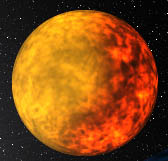|
|
| Line 34: |
Line 34: |
| '''Gravity:''' Unknown Phenomenon. | | '''Gravity:''' Unknown Phenomenon. |
|
| |
|
| '''Sidereal Orbit Period:''' 20.35 Ptolomean Days. | | '''Sidereal Orbit Period:''' 20.35 [[Ptolomea|Ptolomean]] Days. |
|
| |
|
| '''Tilt:''' -8.29° to Ecliptic | | '''Tilt:''' -8.29° to Ecliptic |
|
| |
|
| '''Atmosphere:''' Active Combustion of Extremely High Volumes of Oxygen (97% O) Presumably growing Carbon Dioxide levels (near 2% now) | | '''Atmosphere:''' Active Combustion of Extremely High Volumes of [[starwars:Oxygen|Oxygen]] (97% O) Presumably growing [[starwars:Carbon Dioxide|Carbon Dioxide]] levels (near 2% now) |
|
| |
|
| '''Miscellaneous Info:''' Burning moon, which literally warms the Ptolomean rock. Being so far from the System’s star, this vital relationship between the worlds spells doom in a variety of ways for the thick Jungle world. Should Zanche burn out, [[Ptolomea]] would plunge into a frigid Ice Age after a relatively short period of years. In this a mysterious riddle follows the atmosphere of this moon and the effects on the planet. Zanche creates visible effects of “Day Light” during a portion of its orbital period, which warms the planet below with a rich infrared glow through out the night. This strange pattern of light has surely affected the people who live there and the wildlife of the planet. The relatively speedy rotation of the moon creates a dual tide effect with the other satellite, [[Alberigo]], during certain periods of the month. | | '''Miscellaneous Info:''' Burning [[starwars:moon|moon]], which literally warms the [[Ptolomea|Ptolomean]] rock. Being so far from the System’s star, this vital relationship between the worlds spells doom in a variety of ways for the thick Jungle world. Should Zanche burn out, [[Ptolomea]] would plunge into a frigid Ice Age after a relatively short period of years. In this a mysterious riddle follows the [[starwars:atmosphere|atmosphere]] of this moon and the effects on the planet. Zanche creates visible effects of “Day Light” during a portion of its orbital period, which warms the planet below with a rich infrared glow through out the night. This strange pattern of light has surely affected the people who live there and the wildlife of the planet. The relatively speedy rotation of the moon creates a dual tide effect with the other [[starwars:satellite|satellite]], [[Alberigo]], during certain periods of the month. |
|
| |
|
| [[Category:Scholae Palatinae Dominion]] | | [[Category:Scholae Palatinae Dominion]] |
| [[Category: Planets]] | | [[Category: Planets]] |
Revision as of 08:14, 21 October 2012

|
You plan to take them on.. with just those? This article does not contain very many links to other articles, which would be of use for easy navigation.
After editing is complete, please place a note on the article's talk page and remove this message.
|

|
| Zanche
|
|
Cocytus
|
|
Ptolomea
|
|
House Caliburnus, Clan Scholae Palatinae
|
Zanche is one of the two moons of Ptolomea in the Cocytus System.
Zanche
Mass: 96.113 x 1024 Kg
Circumference: 9,867 Kilometers
Distance from Ptolomea: 349,321 kilometers
Gravity: Unknown Phenomenon.
Sidereal Orbit Period: 20.35 Ptolomean Days.
Tilt: -8.29° to Ecliptic
Atmosphere: Active Combustion of Extremely High Volumes of Oxygen (97% O) Presumably growing Carbon Dioxide levels (near 2% now)
Miscellaneous Info: Burning moon, which literally warms the Ptolomean rock. Being so far from the System’s star, this vital relationship between the worlds spells doom in a variety of ways for the thick Jungle world. Should Zanche burn out, Ptolomea would plunge into a frigid Ice Age after a relatively short period of years. In this a mysterious riddle follows the atmosphere of this moon and the effects on the planet. Zanche creates visible effects of “Day Light” during a portion of its orbital period, which warms the planet below with a rich infrared glow through out the night. This strange pattern of light has surely affected the people who live there and the wildlife of the planet. The relatively speedy rotation of the moon creates a dual tide effect with the other satellite, Alberigo, during certain periods of the month.